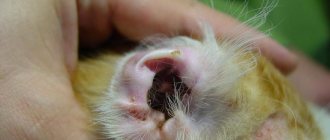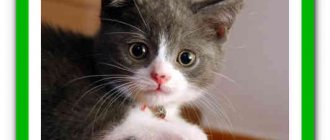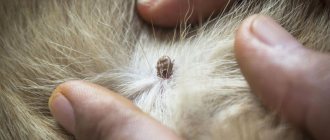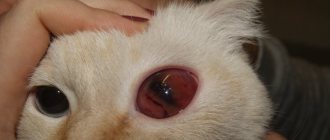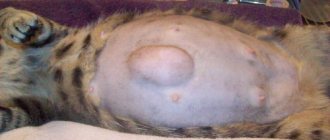13.06.2019
Skin diseases in cats
no comments
4214
Ever since cats became the most popular pets, there seems to be a constant rise in dermatological diseases. One of the common skin diseases, the treatment of which we will look at in this article, is atopic dermatitis .
Statistics show that most individuals with atopy are orange or partly orange (that is, tri-colored or tortoiseshell). Of course, there are different colors, but most atopic cats are orange in color.
Purebred and purebred pets are also more prone to atopy. Allergic atopic dermatitis in cats does not have classic signs, unlike dogs. Therefore, it is necessary to exclude several differential diagnoses before making a diagnosis.
Types of dermatitis in cats and causes
Dermatitis is an inflammatory process that covers the skin and occurs due to a number of provoking factors, such as bacterial infections, parasites, poor diet, etc. In domestic cats, this pathology sometimes has an autoimmune nature, that is, its own defenses begin to attack the cells of the epidermis. The following types of disease are also distinguished:
- simple - occurs when the skin is hypersensitive to external irritants (may appear when constantly wearing a collar, after combing, prolonged exposure to the sun or frost, etc.);
- allergic - often develops with intolerance to certain food ingredients;
- contact - appears due to exposure of the skin to medications, chemicals, shampoos, etc.;
- flea - occurs against the background of infection with blood-sucking parasites (fleas secrete saliva under the skin, which provokes irritation and itching);
- traumatic - develops when the skin is damaged (due to bites of other animals, etc.);
- bacterial - provoked by pathogenic microflora: staphylococci, streptococci, etc.
Dermatitis in cats can occur due to a number of factors.
Causes of pathology:
- decreased immunity;
- hormonal disorders in the pet’s body;
- endocrine diseases;
- cheap and low-quality food with an abundance of synthetic additives;
- infection with worms, fleas, ticks, subcutaneous mites and other parasites;
- treatment with potent medications;
- burns and injuries;
- bacterial infection entering the body.
The disease is not contagious and cannot be transmitted to humans. However, it is important to distinguish dermatitis from lichen. In the latter case, the infection is easily transmitted not only to humans, but also to other animals.
In rare cases, dermatitis appears in a pet after suffering stress. This can happen if the pet has undergone surgery or has had to change its environment due to a move. As a rule, the disease goes away on its own after the cat adapts.
Symptoms of the disease
Pathology manifests itself in the appearance of a red spot on the skin. At first it may be single, then multiple rashes appear, but this does not always happen. The cat constantly scratches the affected area, tries to lick it and bites. At the same time, the animal becomes restless and irritable, and sleeps poorly. As you scratch, the spots become crusty and may become weeping.
Dermatitis in a cat manifests itself at the initial stage as a red spot on the skin
Gradually, the hair in the area of the affected skin begins to fall out. The animal does not eat well and is not as active as before. If a cat constantly scratches its skin, dense red nodules can be seen in areas affected by dermatitis.
Inflammation can be complicated by the addition of a bacterial infection, since a pet’s claws contain a large number of pathogenic microorganisms, including E. coli.
Manifestations of atopic dermatitis
This type of dermatitis can be confused by non-professionals with many other diseases. Its main but practically invisible manifestations are :
- On a cat's skin, the affected areas begin to go bald. Moreover, this can be confused with lichen. But, with atopic dermatitis, the hair along the edges of bald areas does not fray or break, it remains in an absolutely healthy state (this is an important sign). Areas around the eyes, armpits and abdomen have the most sensitive and delicate skin. Therefore, they are the ones most susceptible to damage. The affected areas become covered with ulcers, which very quickly become infected and begin to rot.
- Self-injury of one’s own limbs is another sign. And it can be confused with Aujeszky's disease. During dermatitis, the animal practically begins to “eat” its own paws. At the beginning, the cat will lick its paws with great zeal, biting something. Over time, he will begin to chew the skin on them to blood and bones. If this happens in the spring-summer period, then there is a high probability that the disease could be caused by plant pollen or road dust.
In this case, it is much easier to make a diagnosis, identify the disease in the early stages and begin treatment.
The manifestation of the disease, regardless of the time of year, suggests that the cause must be sought in the cat’s diet. Then the animal will eat only one specific food for the rest of its life.
Atopic dermatitis can be caused by detergents used to clean the home. In order to somehow alleviate the cat’s condition, caring owners immediately begin to completely disinfect their home, which can only worsen the pet’s condition.
© shutterstock
An allergy to dust mites may occur, and the symptoms of the disease can easily be confused with miliary dermatitis. The consequence of an incorrect diagnosis is neglected treatment of the animal and a worsening of its health condition.
Treatment methods
Treatment of the disease is complex. First of all, it is important to identify the provoking factor and eliminate it as soon as possible. For treatment, special food is used, as well as medications that eliminate symptoms. Therapeutic tactics largely depend on the type of dermatitis.
In severe cases, treatment can be carried out in a veterinary clinic using IVs.
Diet food
If the pathology is caused by an allergy to food, then it is necessary to change it to a higher quality one. It is best to give preference to the hypoallergenic option. In addition, it is important to monitor your cat’s immunity. To increase the body's defenses, it is recommended to give your pet vitamins and herbs, which are sold at any veterinary pharmacy.
Hypoallergenic cat food is the best option for pets with allergic dermatitis
It is important to exclude whole milk from your cat’s diet, but kefir, sour cream, cottage cheese and other fermented milk products will be beneficial to the body. Additionally, the animal's menu should include plant fiber, thermally processed meat and grains. Eggs, pork, cartilage and smoked products should not be given to your pet.
You can include sour cream in your cat's diet
The cat's diet should be balanced. It is unacceptable to feed your pet only dry food, as this way the animal will not receive all the vitamins, as well as the plant fiber necessary for proper digestion. A new product should be given to a cat prone to dermatitis in small quantities.
In severe cases of the disease, it is necessary to combine dietary nutrition with drug therapy. This is the only way to achieve a positive result.
Pharmacy drugs
To treat the animal, antihistamines are used, such as Tavegil, Suprastin, Zodak, etc. The dosage of medications is determined by the veterinarian. This line of products eliminates itching, which speeds up skin healing. However, you need to understand that antihistamines only relieve symptoms, and not the cause itself.
Tavegil is an antiallergic drug that is often prescribed to treat not only people, but also animals.
In severe cases of the disease, glucocorticosteroid drugs such as Prednisolone, Hydrocortisone and others are used for treatment. This group of medications is prescribed in the form of ointments, which must be applied directly to the affected area once a day. This eliminates swelling, inflammation and itching. When using ointments, you must wear gloves and use a blanket that will prevent your pet from licking the medicine.
Prednisolone reduces the intensity of the inflammatory process
Special medications intended for cats are also used for therapy. One of them is Stop Itching. It relieves unpleasant symptoms and accelerates the healing of damaged skin. Can be used for adults and small animals.
Stop itching for cats is designed to eliminate allergic reactions
Simple and traumatic types of dermatitis are eliminated with the help of healing ointments, creams and solutions that are used to treat the affected skin. For these purposes, you can use Chlorhexidine, Miramistin, and iodine. The first 2 drugs have a complex effect: eliminate inflammation, destroy pathogenic microflora and promote tissue healing. These solutions should be applied 3 times a day, treating the damaged area with a cotton pad. The course of treatment depends on the severity of the inflammatory process.
Chlorhexidine has an antiseptic effect
Iodine should not be applied to the affected area; it can cause increased pain and even greater damage to the skin. The solution can only be applied to the area around the wound to prevent infection. For these purposes, it is recommended to use a cotton swab.
Iodine should be applied carefully and only with a cotton swab
The contact form of the disease is eliminated with the help of regenerating agents. Zinc ointment is often used for treatment, which dries the skin, eliminating weeping and accelerating the restoration of damaged tissue. This product should be used 2 times a day. Veterinarians first recommend cutting the hair in the affected area. This will make the procedure easier. After applying the composition in a thin layer, you need to put a blanket on your pet.
Zinc ointment accelerates wound healing
Salicylic ointment is often prescribed as an antiseptic and anti-inflammatory agent. It can be used only after the cause of dermatitis has been established. Apply the product 2 times a day in a thin layer to the area of inflammation. The course of treatment is often 10 to 14 days, depending on the extent of the skin lesion.
Salicylic ointment eliminates inflammation and promotes regeneration
Flea dermatitis is eliminated using a complex of drugs. At the first stage, parasite removal agents are used. The most effective are insecticidal drops on the withers, aerosols, sprays and shampoos. Veterinarians recommend using the first option. Most often used: Advantage, Bars and Dana. Drops are applied to the withers once. If necessary, you can repeat the procedure in a month. Sprays and aerosols are more difficult to use, since in this case the pet’s head must be isolated from contact with the product. A special collar is used for this.
Bars drops against fleas - easy to use and effective remedy
After eliminating the fleas, anti-inflammatory and wound healing agents are used, such as Yam ointment and others. For a bacterial form of the disease, a course of antibiotics is prescribed. Most often, Amoxicillin, Azithromycin, Terramycin, etc. are used for treatment. Such drugs are given to the animal regularly for 7–10 days. The dose is determined by the veterinarian. The tablets can be given by syringe or mixed with food. Erythromycin, tetracycline and other antibacterial ointments are used locally. Apply them in a thin layer to the inflammatory element. To successfully eliminate bacterial flora, veterinarians recommend combining oral medications with local agents.
Amoxicillin can be used to treat cats
Attention! Under no circumstances should you give antibiotics to your pet without first undergoing tests. Otherwise, you can only make the situation worse. Many antimicrobial agents can reduce a cat’s immunity and also have a lot of side effects. That is why only a veterinarian should set the dose.
My mother's cat had allergic dermatitis. The symptoms were mild at first. The cat started to itch. Then the itching became more and more intense. The cat was scratching its belly vigorously. As a result, all the fur in this area came out. There were only red spots and scratches left on the stomach. The veterinarian took the necessary tests and recommended using Prednisolone in the form of an ointment for treatment, as well as including hypoallergenic food in the diet. It soon became noticeable that the scratching wounds had disappeared, and the stomach began to grow overgrown with fur. I recommend everyone to consult a doctor with their pet in a timely manner to avoid serious consequences.
Treatment of disease in kittens
Pathology in kittens can be eliminated only with the help of local remedies. Treatment should consist of several stages:
- Elimination of itching. At this stage, antihistamines are used for treatment, the same as for adult cats, only in the form of ointments. The composition is applied to damaged areas 2 times a day. The course of treatment depends on the cause.
- Reducing the intensity of the inflammatory process. At this stage, Chlorhexidine, Miramistin and Stop Itching are used. These medications are applied with a cotton pad 2 times a day. The course of therapy is from 7–10 days.
- Healing damaged skin. To accelerate tissue regeneration in kittens, Bepanten cream is used. It is applied in a thin layer, gently rubbing into the skin once a day.
Bepanten is used to heal the skin of kittens with dermatitis
During treatment, it is not recommended to worm kittens (unless this is the cause, of course) or give other medications, as this can cause an increase in the symptoms of dermatitis.
Diagnosis and treatment at home
During the diagnosis, the veterinarian finds out what was the root cause of the disease. To do this, the doctor will find out what the animal eats and whether it has been in contact with chemicals or new drugs for parasites. He also evaluates accompanying symptoms and makes a diagnosis based on these data. If you suspect the presence of a tick, be sure to take a scraping.
First of all, the root cause of the disease is eliminated.
If the dermatitis was caused by parasites, they are destroyed with anthelmintic or flea medications. In case of allergies, it is necessary to exclude the animal’s contact with the allergen.
After eliminating the root cause, begin symptomatic treatment:
- The fur on the affected areas is shaved or clipped.
- Damaged skin is treated with an antiseptic, the crusts are soaked and removed.
- Ointments containing an antibiotic (Levomekol, Clindamycin, Tetracycline, etc.) are applied to the affected areas.
- In case of severe damage, injection of drugs is used.
- The animal is given drugs that relieve itching (Tavegil, Suprastin, etc.).
Bepanthen, solcoseryl, celestoderm are effective for dermatitis.
Bepanthen cream for external use
These drugs promote accelerated healing, eliminate itching, and prevent infection from entering wounds.
Animal care and prevention
During illness, you need to ensure that your pet always has fresh boiled water in his bowl. It is advisable to arrange a cozy and quiet place for the cat where she can rest. For these purposes, it is recommended to purchase a special bedding. If an animal wants privacy and avoids contact, then you should not interrupt its rest, pet it or pick it up.
During illness, it is not recommended to comb the fur, as the skin can be damaged even more.
If possible, you should open the window so that your pet can breathe fresh air. However, hypothermia should not be allowed. Enough ventilation. It is not recommended to bathe your cat during treatment for dermatitis. Particular attention should be paid to the area of localization of inflammation. It is important to ensure that your pet does not scratch its skin. For this purpose, it is not recommended to remove the blanket until complete recovery.
During the recovery period, the cat needs peace and quiet.
How to prevent the occurrence of the disease:
- Feed your pet only specialized food, avoiding low-quality options.
- Balance your pet’s diet so that the menu includes not only dry food, but also other healthy foods.
- Bathe the animal once every 4–6 months, provided that the cat does not go outside. Otherwise, this should be done more often.
- Worm the cat once a quarter.
- Do not give your pet medications unless prescribed by a veterinarian.
- Buy an anti-flea collar and put it on your cat. This is especially important if the animal is often outside.
- Give your four-legged friend vitamins, as well as special grass rich in healthy fiber.
Grass for cats is a source of fiber that strengthens the immune system.
To prevent the occurrence of dermatitis, many veterinarians recommend regularly examining the animal's skin to identify the first symptoms of the disease. Vaccination should also not be neglected.
Diagnostics
Any symptoms that make a cat owner think about this disease should prompt an urgent visit to the veterinarian.
Even experienced doctors are unable to make such a diagnosis after a visual examination of the animal: tests will be required to determine the disease.
Blurred symptoms may be similar to signs of other diseases:
- flea dermatitis;
- simple food allergies;
- ear mites;
- Aujeszky's disease;
- depriving.
Therefore, when going for an appointment, remember in advance what your pet has been eating lately, what brand of food he eats most often.
If possible, information about the pedigree will not hurt - if the cat had similar problems in his family, this increases the likelihood of diagnosing atopic dermatitis.
To recognize the disease, the doctor will prescribe tests:
- urine;
- feces;
- blood;
- skin scrapings;
- wool
An allergy test is also required to accurately determine the causative agent of the allergy.
Reference!
As can be understood from the list of required studies, such tests cannot be collected in every veterinary clinic. Choose a veterinarian responsibly, read the reviews, or better yet, call in advance and find out if he will take the necessary tests.
The more research the doctor conducts, the higher the likelihood of making a correct diagnosis.


